Raising pigs can become a satisfying enterprise even for beginners. Choosing what pig to raise is important for anyone’s success in pig production. Heritage pigs, although they are becoming rare, are great choices due to having better meat quality.
Heritage pigs are the original breeds of pigs brought to the Americas by early explorers. They have varying origins as they were imported from other countries, including Spain, England, and Portugal. Most breeds went under intensive husbandry for genetic diversity.
To know more about heritage pigs, their history, appearances, distinctive characteristics, and other interesting information, read this article further!
Heritage Pig History
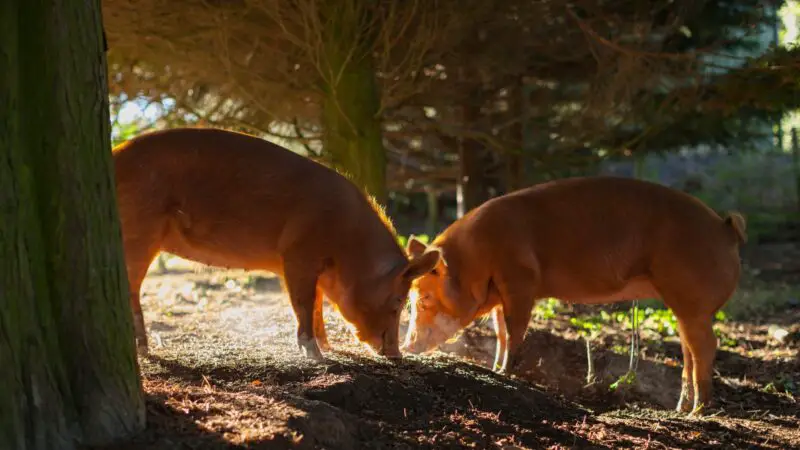
Heritage pigs were first introduced in the Americas in 1493 by early explorers such as Christopher Columbus. These were imported from Portugal, Spain, England, and other countries. Big China, the Berkshire, and the Irish Grazier, the most commonly imported breeds, used to improve common pig stocks.
As farms in the Midwest began to produce too much corn, the availability and low cost of corn-based feed prompted the influx of pig production and processing in the region. By the mid-19th century, pig production declined in New and East England to the point of extinction of some heritage breeds by the early 20th century.
When the market for lard declined during World War II, breeders began producing leaner meat and selecting pigs for their muscling instead of fattening when fed with corn. Most of the industry loved the Hampshire, Berkshire, Yorkshire, Duroc, and Poland China breeds. These breeds possessed the genetic diversity required for selection.
Several heritage pig breeds remain but are barely clinging on to survival because the pork industry relies largely on a three-way cross between selected strains of Yorkshire, Hampshire, and Duroc pigs, all of which undergo intensive husbandry.
What Do Heritage Pigs Look Like?
Here are some of the several breeds of heritage pigs and their appearance:
| Breed | Appearance |
| Choctaw | Small-sized pigs with an athletic build, black colouration but occasionally with white markings, erect or slightly drooping ears, and long legs. |
| Gloucestershire Old Spots | Large-sized pigs with predominantly white with black spots and heavily-drooped ears |
| Guinea Hog | Small-sized pigs with squarish bodies, long tails, reddish bristly hair, and pointed ears. |
| Hereford | Reddish pig with a white head and face, floppy ears, a medium-length face that is slightly dished, and long neck |
| Large Black | Large-sized pigs with straight faces, long heads, heavily-drooped ears, strong backs, and fine, thick, black hair. |
| Meishan | Medium-sized pig with a gray or black coloration, wrinkled skin, pink or white socks, and drooping ears. |
| Mulefoot | Compact-bodied pigs are mainly black but can have white points. It also has pricked ears and wattles, but the latter is rare. |
| Ossabaw Island | Small-sized pigs with heavy coats can be black, red, spotted black and white, or tan, with prick ears and long snouts. |
| Red Wattle | Large-sized pigs can be shades of red, occasionally with black patches or spots. They also have slim noses and drooping ears. |
| Tamworth | Medium-sized pigs have long legs, lean overall bodies, ginger coats, elongated heads, and erect, pointed ears. |
How Long Does a Heritage Pig Live?
Their life expectancy is sometime between 15 to 20 years. However, pigs raised for commercial or market purposes are sent to slaughterhouses as early as 6 months of age.
What Do Heritage Pigs Eat?
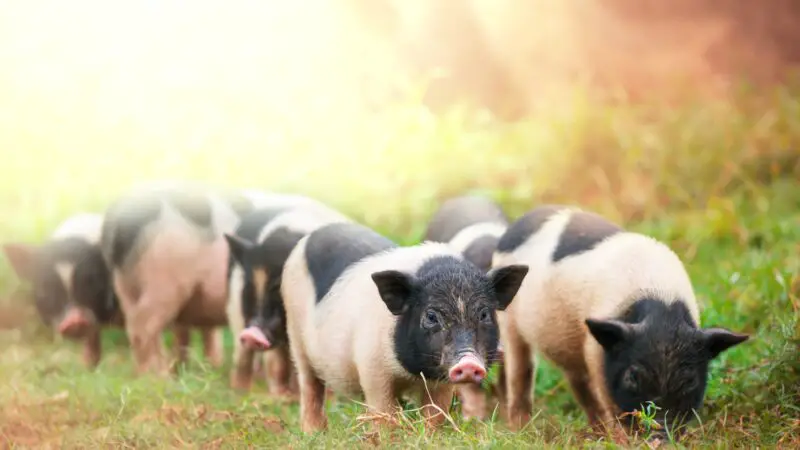
Heritage pigs, like all other pigs, require carbohydrates and fats from grains and roughage such as corn silage, alfalfa, and pasture. They also need supplements and proteins, minerals, and vitamins. Legumes and young grasses are also excellent sources of vitamins.
How Big Do Heritage Pigs Grow?
Heritage pigs stand about 22 inches to 4 feet in height and up to 8 feet in length, depending on the breed.
Are Heritage Pigs a Heavy Breed?
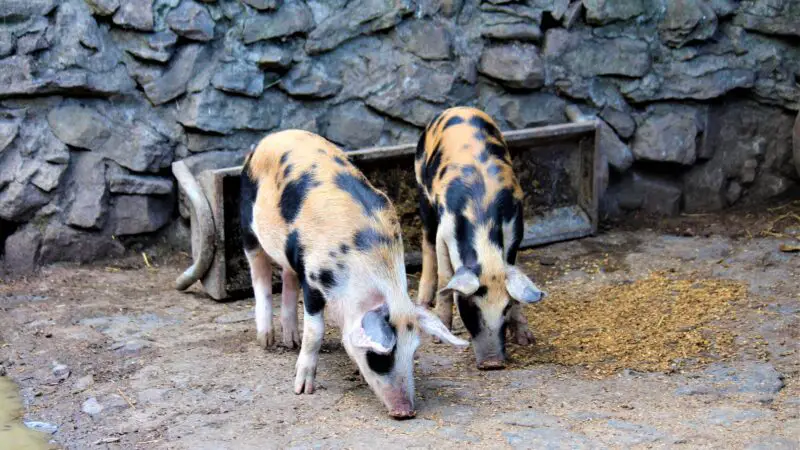
It depends on the particular breed. They can be as lightweight as 150 pounds (Guinea Hogs) and as heavy as 800 pounds (Hereford, Large Black Pig, and Red Wattle).
What Is Heritage Pig Known For?
Heritage pigs are grown for bacon or lard. Lard breeds can produce lard which is a mechanical lubricant and cooking fat. At the same time, bacon pigs are lean and muscular and are traditionally fed with turnips, legumes, dairy byproducts, small grains, and feeds that are protein-rich and low in energy.
Where Do Heritage Pigs Originate?
They were imported from other countries, including Spain, England, Portugal, Ireland, and China, although some breeds originated from the United States.
What Are the Distinct Characteristics of a Heritage Pig?
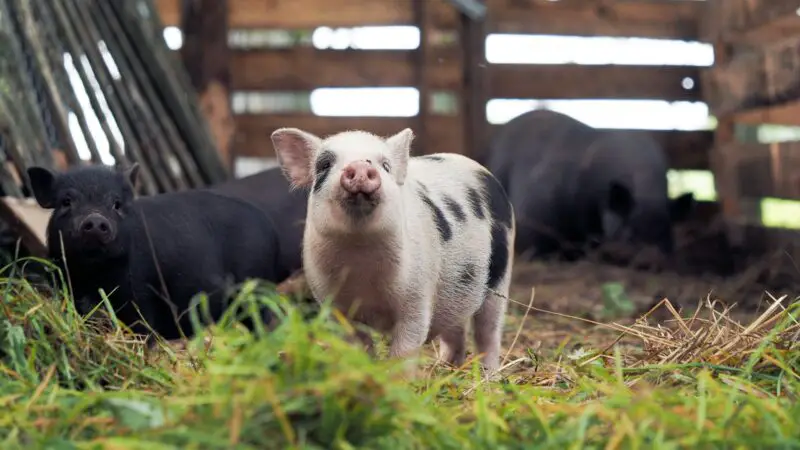
All heritage pig breeds can adapt to various climates if provided with shelter, protection, water, and shade from extreme weather conditions. Most breeds have good foraging and mothering abilities.
Heritage Pig Temperament
Heritage pigs are generally docile, except the Choctaw pig, which is known to be aggressive. There are also active breeds such as Mulefoot and Tamworth.
Heritage Pig Care Tips
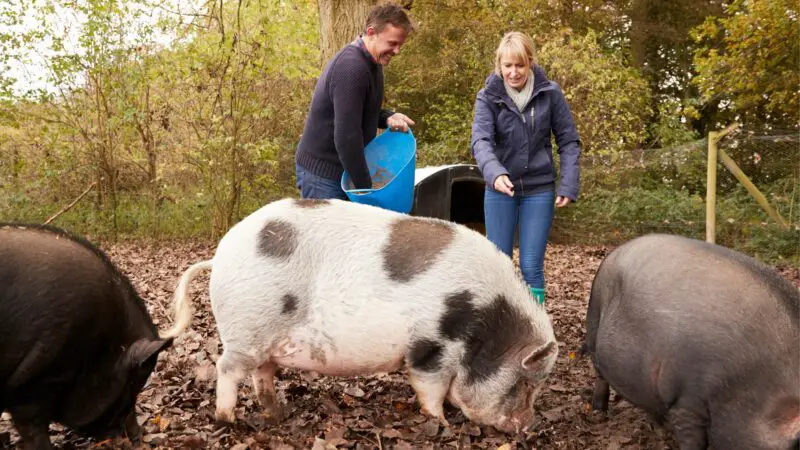
Spacing
Pigs generally require little space—only 8 square feet per pig. This is because they have rather idle behaviors since they eat, sleep, or root. You would, however, need more space if you can’t provide indoor shelter for your pigs, as they can get quite destructive when rooting or running to horses.
Housing
The shelter you provide for your pigs doesn’t need to be extravagant. A three-sided, open shelter on the fourth side will do, as long as the pigs have access to pasture. It should also have a low roof with openings that can provide airflow. Indoor facilities should preferably have an attic and electric fans to promote ventilation.
Feeders and Waterers
Heritage pigs need easy access to food and water 24 hours daily. You can purchase a self-feeder at a feed store or build one yourself. Ensure to place waterers away from the pigs’ feeding areas since they naturally learn to defecate near water sources. It also helps to widen the distance if your pig pens are rectangular instead of circular or square.
Nutrition
Nutritionally-balanced pig diets contain energy and amino acids. Energy feeds usually contain corn and other small grains such as wheat, barley, oats, and triticale. You can use alternatives such as dried distiller grains with solubles, vegetable oils, and corn gluten meal or feed.
Furthermore, heritage pigs will require protein feeds to supplement the amino acids they need. Soybean meal is the most commonly used feedstuff for pigs. There are also alternatives such as field peas, whole soybeans, alfalfa meal, sunflower meal, canola meal, fish meal, linseed meal, meat or bone meal, and linseed meal.
Health and Wellness
To prevent diseases, make sure to keep pig pens clean. Provide your pigs with comfortable living conditions and clean food and drinking water. Avoid mixing pigs when they’re bought from different sellers.
Maintain a good relationship with your local veterinarian, extension officer, or other professionals when raising heritage pigs because they are susceptible to bacterial infections, soil-based parasites, and viruses, including those mutated from human diseases.
Here are some common diseases to look out for:
- Erysipelas or Diamond Skin Disease. This bacteria is present in almost half of the swine population in the United States. It is spread through nose-to-nose contact and in the feces of infected pigs or birds. Symptoms are high fever, diamond-shaped rashes or welts on their backs, and joint pain.
- Atrophic Rhinitis. Caused by bacteria found in wet beddings, this disease can affect pigs as young as a week old. Common signs are nasal discharge, sneezing and snorting, watery eyes, and a crooked snout.
- Sunburn. This occurs when piglets are moved into a sunlit pig pen for the first time or after the pigs have been clipped or washed. This is seldom fatal but can be very painful for the pig. It can also cause scabs or peeling skin.
- Scours. It can either be caused by parasites, bacteria, or nutrition. Common signs are loose stools or diarrhea, reduced appetite, or anorexia.
- Internal Parasites. Roundworms are the most common, and coughing is one of the first clinical symptoms. Other signs are allergic reactions, unthrifty appearance, and weight loss.
Breeding Heritage Pigs
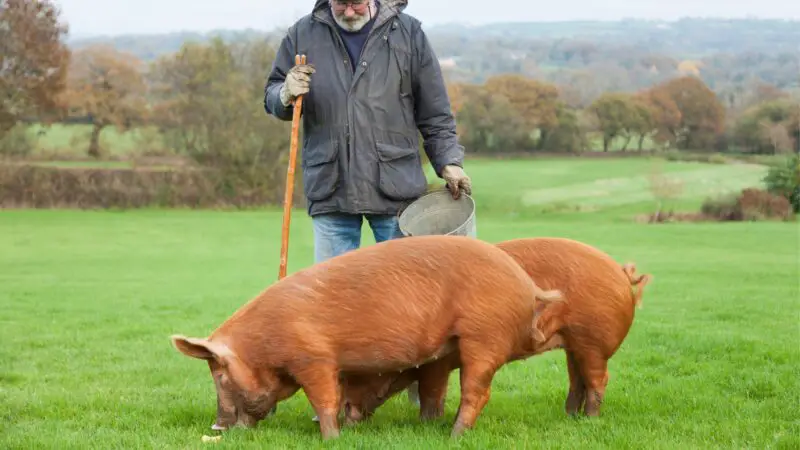
This is through pen mating (wherein the boars run with the females), hand mating (a supervised method of natural mating), and artificial insemination. Pen mating is generally used for smaller pig operations.
As an owner, you are tasked with managing the reproductive herd’s temperature, aggressive behavior, ventilation, nutrition, and body conditions. Body condition scoring is usually used to make these respective estimations. All these will affect the longevity and genetics of the resulting new generation of pigs.
